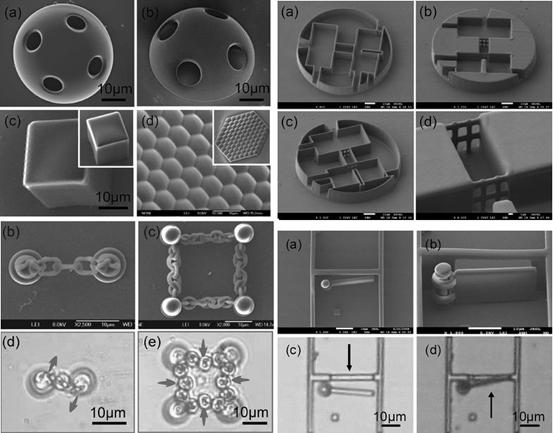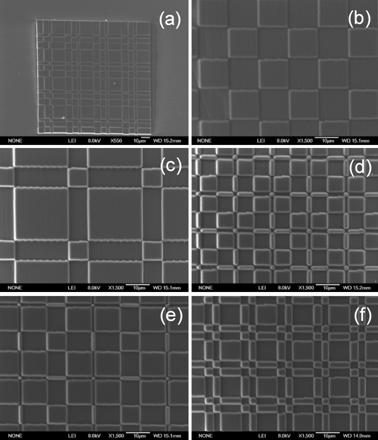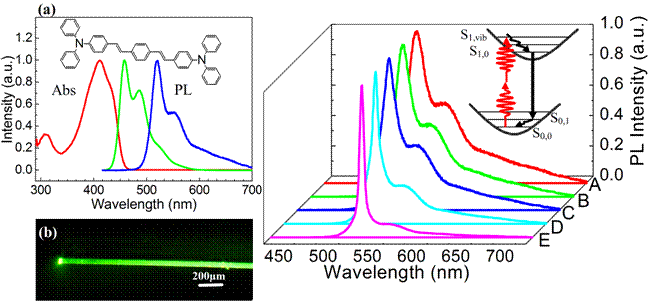
|

Microfluidic researches are now resorting to advanced micro-nanoprocessing technologies for production of more functional lab-on-a-chip systems. However, two-photon polymerization (TPP), a powerful designable micro-nanofabrication approach, has not been put to use on the exciting field, largely due to the difficulties in forming buried channels. Here, we solve the problem by TPP prototyping of nanoshells, for which the usage of the negative tone resin SU-8 is found critical. The fabrication efficiency improved by orders of magnitude, together with the prospect of integration of movable micro-mechanical and optical components into the chip would make TPP a promising enabling tool for the micro-analytical systems. Finally, a 25 μm length functional microvalve in a microfluidic channel was rapidly realized and its ON and OFF states were tested.
.

Dammann gratings fabricated by two-photon photopolymerization. (a) Top-view SEM image and locally magnified views of the Dammann gratings that generate (b) 2×2, (c) 3×3, (d) 4×4, (e) 5×5 and (f) 6×6 spot sources respectively.
.

We synthesized surface-modified Fe3O4 nanocrystals and doped them in the photopolymerizable resin. Then such resin which contained magnetic nano-particles was pinpoint written by femtosecond laser-induced two-photon photopolymerization to create microsprings. Due to the nature of superparamagnetism of Fe3O4 nanoparticles in the micro-machines, they are sensitive to exerted magnetic force. Thus, by shifting the position of the ferromagnet at the side of the microspring, various motions have been induce, such as elongate, bend and etc. When the ferromagnet was withdrawn far, the spring was recovered to its initial situation owing to the superparamagnetic nature of the nanoparticles.As a noncontact, sensitive, easy, and environmentally friendly approach, the magnetic driving of micronanomachines may play an important role for nano and biological applications.
Juan Wang's Opt. Lett. 34, 581 (2009).

Organic crystals can have many charming properties that allow for novel approaches to making photonic devices. One of the most amazing aspects is the fluorescence up-conversion and can be implemented through two-photon absorption, where two photons are absorbed simultaneously to excite electron into high energy level. Performance of tunability and absence of phase-matching make two-photon pumped (TPP) lasing promising candidate for frequency-upconversion lasing. The combination of strong nonlinear absorption with high fluorescence efficiency allows us to demonstrate one of the world's very few two-photon pumped solid-state organic lasers, pumped at 800 nm, highlighting some of the unique possibilities that organic crystals open up for laser devices.
.

We have investigated the origin of the optical zero-transmission regions in different kinds of highly symmetric quasicrystal structures (a&b). We report on the possibility of reproducing the same optical characteristics by using some of the constituent parts of the quasicrystals (structure made by black line), arranged in standard photonic crystal geometries showing translational symmetry. This finding represents a challenge to the common assumption that high-order symmetry is the reason for the large optical zero-transmission regions shown by quasicrystals. This insight into the field of quasiperiodic photonic devices opens up key questions about opportunities for quasicrystals in optical applications.
.

.
Current controversy on the binding sites of H+ in ZnO can be explained by first-principles calculations. Previous infrared measurements from different groups indicate different H sites, either at the bond center (BC) site with a stretch frequency Omega=3611cm-1 or antibonding (AB) site with Omega=3326cm-1 . This was puzzling because the BC site has lower energy by 0.2 eV. Here, we show that calcium, isovalent to Zn and found only in samples with the 3326cm-1 mode, binds H at the AB site. Large spatial undulation of charge explains the unexpected large binding between isovalent Ca and charged H+ of 0.7 eV.
.
